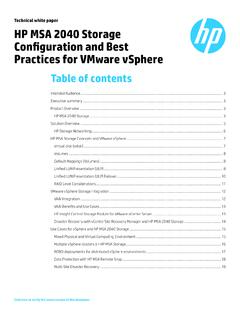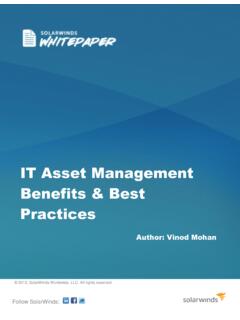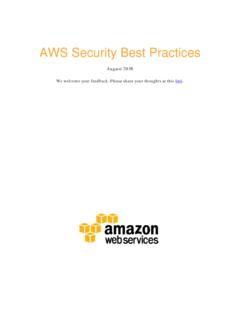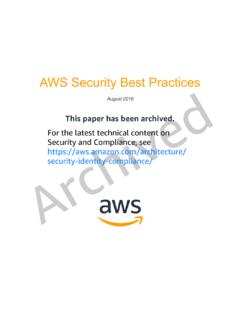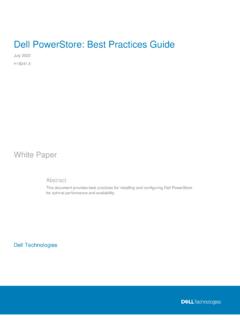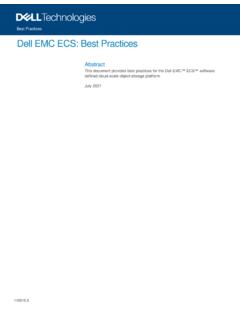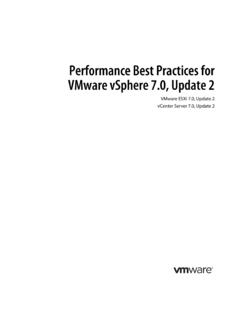Transcription of Serverless Architectures with AWS Lambda
1 This paper has been archivedFor the latest technical content, refer t o the AWS Wh i t epapers & Guides page: Serverless Architectures with AWS Lambda Overview and best practices November 2017 This paper has been archivedFor the latest technical content, refer t o the AWS Wh i t epapers & Guides page: 2017, Amazon Web Services, Inc. or its affiliates. All rights reserved. Notices This document is provided for informational purposes only. It represents AWS s current product offerings and practices as of the date of issue of this document, which are subject to change without notice. Customers are responsible for making their own independent assessment of the information in this document and any use of AWS s products or services, each of which is provided as is without warranty of any kind, whether express or implied. This document does not create any warranties, representations, contractual commitments, conditions or assurances from AWS, its affiliates, suppliers or licensors.
2 The responsibilities and liabilities of AWS to its customers are controlled by AWS agreements, and this document is not part of, nor does it modify, any agreement between AWS and its customers. This paper has been archivedFor the latest technical content, refer t o the AWS Wh i t epapers & Guides page: Contents Introduction - What Is Serverless ? 1 AWS Lambda the Basics 2 AWS Lambda Diving Deeper 4 Lambda Function Code 5 Lambda Function Event Sources 9 Lambda Function configuration 14 Serverless best practices 21 Serverless architecture best practices 21 Serverless Development best practices 34 Sample Serverless Architectures 42 Conclusion 42 Contributors 43 This paper has been archivedFor the latest technical content, refer t o the AWS Wh i t epapers & Guides page: Abstract Since its introduction at AWS re:Invent in 2014, AWS Lambda has continued to be one of the fastest growing AWS services. With its arrival, a new application architecture paradigm was created referred to as Serverless .
3 AWS now provides a number of different services that allow you to build full application stacks without the need to manage any servers. Use cases like web or mobile backends, real-time data processing, chatbots and virtual assistants, Internet of Things (IoT) backends, and more can all be fully Serverless . For the logic layer of a Serverless application, you can execute your business logic using AWS Lambda . Developers and organizations are finding that AWS Lambda is enabling much faster development speed and experimentation than is possible when deploying applications in a traditional server-based environment. This whitepaper is meant to provide you with a broad overview of AWS Lambda , its features, and a slew of recommendations and best practices for building your own Serverless applications on AWS. This paper has been archivedFor the latest technical content, refer t o the AWS Wh i t epapers & Guides page: Amazon Web Services Serverless Architectures with AWS Lambda Page 1 Introduction - What Is Serverless ?
4 Serverless most often refers to Serverless applications. Serverless applications are ones that don't require you to provision or manage any servers. You can focus on your core product and business logic instead of responsibilities like operating system (OS) access control, OS patching, provisioning, right-sizing, scaling, and availability. By building your application on a Serverless platform, the platform manages these responsibilities for you. For service or platform to be considered Serverless , it should provide the following capabilities: No server management You don t have to provision or maintain any servers. There is no software or runtime to install, maintain, or administer. Flexible scaling You can scale your application automatically or by adjusting its capacity through toggling the units of consumption (for example, throughput, memory) rather than units of individual servers. High availability Serverless applications have built-in availability and fault tolerance.
5 You don't need to architect for these capabilities because the services running the application provide them by default. No idle capacity You don't have to pay for idle capacity. There is no need to pre-provision or over-provision capacity for things like compute and storage . There is no charge when your code isn t running. The AWS Cloud provides many different services that can be components of a Serverless application. These include capabilities for: Compute AWS Lambda1 APIs Amazon API Gateway2 storage Amazon Simple storage Service (Amazon S3)3 Databases Amazon DynamoDB4 Interprocess messaging Amazon Simple Notification Service (Amazon SNS)5 and Amazon Simple Queue Service (Amazon SQS)6 Orchestration AWS Step Functions7 and Amazon CloudWatch Events8 This paper has been archivedFor the latest technical content, refer t o the AWS Wh i t epapers & Guides page: Amazon Web Services Serverless Architectures with AWS Lambda Page 2 Analytics Amazon Kinesis9 This whitepaper will focus on AWS Lambda , the compute layer of your Serverless application where your code is executed, and the AWS developer tools and services that enable best practices when building and maintaining Serverless applications with Lambda .
6 AWS Lambda the Basics Lambda is a high-scale, provision-free Serverless compute offering based on functions. It provides the cloud logic layer for your application. Lambda functions can be triggered by a variety of events that occur on AWS or on supporting third-party services. They enable you to build reactive, event-driven systems. When there are multiple, simultaneous events to respond to, Lambda simply runs more copies of the function in parallel. Lambda functions scale precisely with the size of the workload, down to the individual request. Thus, the likelihood of having an idle server or container is extremely low. Architectures that use Lambda functions are designed to reduce wasted capacity. Lambda can be described as a type of Serverless Function-as-a-Service (FaaS). FaaS is one approach to building event-driven computing systems. It relies on functions as the unit of deployment and execution. Serverless FaaS is a type of FaaS where no virtual machines or containers are present in the programming model and where the vendor provides provision-free scalability and built-in reliability.
7 Figure 1 shows the relationship among event-driven computing, FaaS, and Serverless FaaS. This paper has been archivedFor the latest technical content, refer t o the AWS Wh i t epapers & Guides page: Amazon Web Services Serverless Architectures with AWS Lambda Page 3 Figure 1: The relationship among event-driven computing, FaaS, and Serverless FaaS With Lambda , you can run code for virtually any type of application or backend service. Lambda runs and scales your code with high availability. Each Lambda function you create contains the code you want to execute, the configuration that defines how your code is executed and, optionally, one or more event sources that detect events and invoke your function as they occur. These elements are covered in more detail in the next section. An example event source is API Gateway, which can invoke a Lambda function anytime an API method created with API Gateway receives an HTTPS request. Another example is Amazon SNS, which has the ability to invoke a Lambda function anytime a new message is posted to an SNS topic.
8 Many event source options can trigger your Lambda function. For the full list, see this Lambda also provides a RESTful service API, which includes the ability to directly invoke a Lambda You can use this API to execute your code directly without configuring another event source. You don t need to write any code to integrate an event source with your Lambda function, manage any of the infrastructure that detects events and delivers them to your function, or manage scaling your Lambda function to match the number of events that are delivered. You can focus on your application logic and configure the event sources that cause your logic to run. This paper has been archivedFor the latest technical content, refer t o the AWS Wh i t epapers & Guides page: Amazon Web Services Serverless Architectures with AWS Lambda Page 4 Your Lambda function runs within a (simplified) architecture that looks like the one shown in Figure 2. Figure 2: Simplified architecture of a running Lambda function Once you configure an event source for your function, your code is invoked when the event occurs.
9 Your code can execute any business logic, reach out to external web services, integrate with other AWS services, or anything else your application requires. All of the same capabilities and software design principles that you re used to for your language of choice will apply when using Lambda . Also, because of the inherent decoupling that is enforced in Serverless applications through integrating Lambda functions and event sources, it s a natural fit to build microservices using Lambda functions. With a basic understanding of Serverless principles and Lambda , you might be ready to start writing some code. The following resources will help you get started with Lambda immediately: Hello World tutorial: Serverless workshops and walkthroughs for building sample applications: AWS Lambda Diving Deeper The remainder of this whitepaper will help you understand the components and features of Lambda , followed by best practices for various aspects of building and owning Serverless applications using Lambda .
10 This paper has been archivedFor the latest technical content, refer t o the AWS Wh i t epapers & Guides page: Amazon Web Services Serverless Architectures with AWS Lambda Page 5 Let s begin our deep dive by further expanding and explaining each of the major components of Lambda that we described in the introduction: function code, event sources, and function configuration . Lambda Function Code At its core, you use Lambda to execute code. This can be code that you ve written in any of the languages supported by Lambda (Java, , Python, or C# as of this publication), as well as any code or packages you ve uploaded alongside the code that you ve written. You re free to bring any libraries, artifacts, or compiled native binaries that can execute on top of the runtime environment as part of your function code package. If you want, you can even execute code you ve written in another programming language (PHP, Go, SmallTalk, Ruby, etc.), as long as you stage and invoke that code from within one of the support languages in the AWS Lambda runtime environment (see this tutorial).










